engine Citroen C4 PICASSO 2013 1.G Owners Manual
[x] Cancel search | Manufacturer: CITROEN, Model Year: 2013, Model line: C4 PICASSO, Model: Citroen C4 PICASSO 2013 1.GPages: 420, PDF Size: 9.66 MB
Page 312 of 420
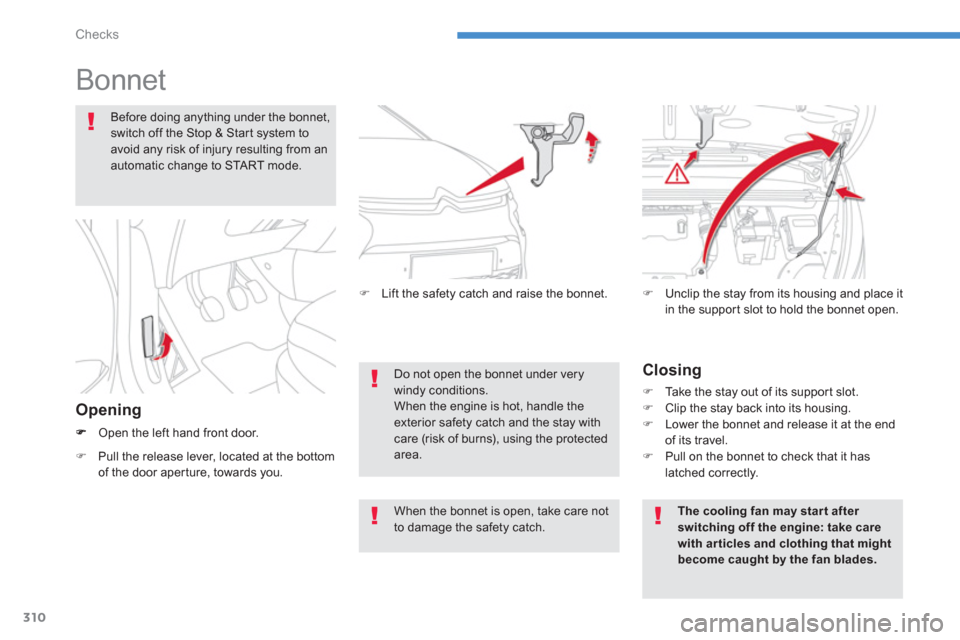
310
Checks
Bonnet
Open the left hand front door.
Do not open the bonnet under verywindy conditions.When the engine is hot, handle the exterior safety catch and the stay with care (risk of burns), using the protected area.
�)
Lift the safety catch and raise the bonnet.
�)Unclip the stay from its housing and place it
in the support slot to hold the bonnet open.
Opening
�)Pull the release lever, located at the bottom
of the door aper ture, towards you.
Before doing anything under the bonnet,switch off the Stop & Start system toavoid any risk of injury resulting from anautomatic change to START mode.
The cooling fan may star t after switching off the engine: take care with ar ticles and clothing that might become caught by the fan blades.
Closing
�)Take the stay out of its suppor t slot. �)Clip the stay back into its housing. �)Lower the bonnet and release it at the end of its travel. �)Pull on the bonnet to check that it haslatched correctly.
When the bonnet is open, take care not to damage the safety catch.
Page 313 of 420
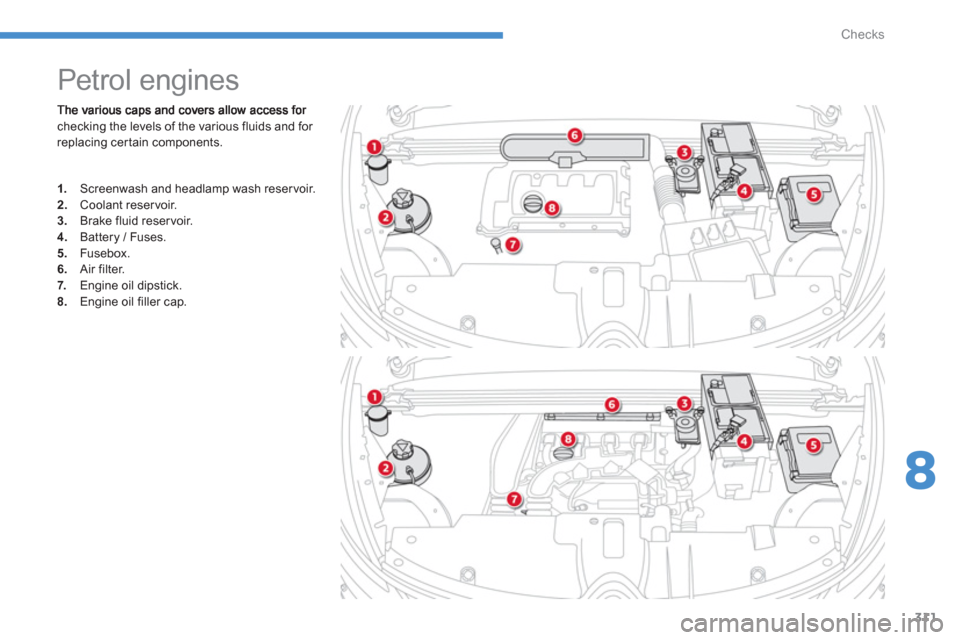
311
8
Checks
checking the levels of the various fluids and for
replacing cer tain components.
Petrol engines
1.
Screenwash and headlamp wash reser voir.2.Coolant reservoir.3.Brake fluid reservoir.4.
Battery / Fuses.
5. Fusebox.
6.Air filter.
7. Engine oil dipstick.8.Engine oil filler cap.
Page 314 of 420
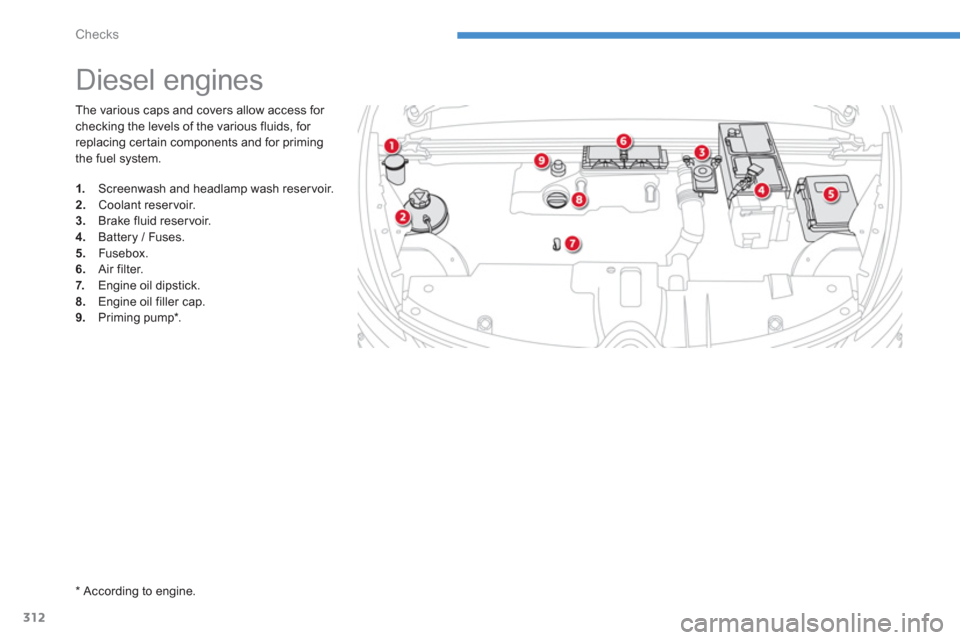
312
Checks
The various caps and covers allow access for checking the levels of the various fluids, for replacing cer tain components and for primingthe fuel system.
Diesel engines
1.
Screenwash and headlamp wash reser voir.2.
Coolant reservoir. 3.
Brake fluid reservoir.4.
Battery / Fuses. 5.
Fusebox.
6.Air filter.
7. Engine oil dipstick. 8.Engine oil filler cap.9.
Priming pump * .
*
According to engine.
Page 315 of 420
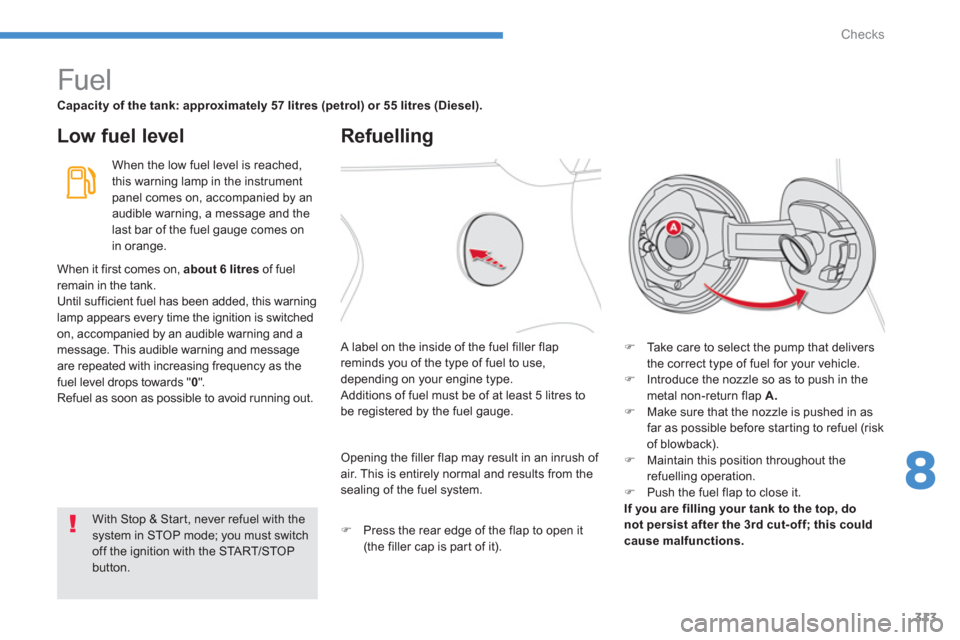
313
8
Checks
Fuel
Capacity of the tank: approximately 57 litres (petrol) or 55 litres (Diesel).
Low fuel level
Refuelling
When the low fuel level is reached,
this warning lamp in the instrumentpanel comes on, accompanied by anaudible warning, a message and the
last bar of the fuel gauge comes on in orange.
�) Take care to select the pump that delivers
the correct type of fuel for your vehicle.�) Introduce the nozzle so as to push in themetal non-return flap A.�)
Make sure that the nozzle is pushed in as
far as possible before star ting to refuel (risk
of blowback). �) Maintain this position throughout the
refuelling operation.�) Push the fuel flap to close it.
If you are filling your tank to the top, do
not persist after the 3rd cut- off; this could cause malfunctions.
A label on the inside of the fuel filler flapreminds you of the type of fuel to use,
depending on your engine type.
Additions of fuel must be of at least 5 litres to
be registered by the fuel gauge. When it
first comes on, about 6 litresof fuel
remain in the tank.
Until sufficient fuel has been added, this warninglamp appears every time the ignition is switched
on, accompanied by an audible warning and amessage. This audible warning and message
are repeated with increasing frequency as the fuel level drops towards "0".
Refuel as soon as possible to avoid running out.
Opening the filler flap may result in an inrush of air. This is entirely normal and results from the
sealing of the fuel system.
�) Press the rear edge of the flap to open it
(the filler cap is par t of it).
With Stop & Star t, never refuel with the
system in STOP mode; you must switchoff the ignition with the START/STOP button.
Page 316 of 420
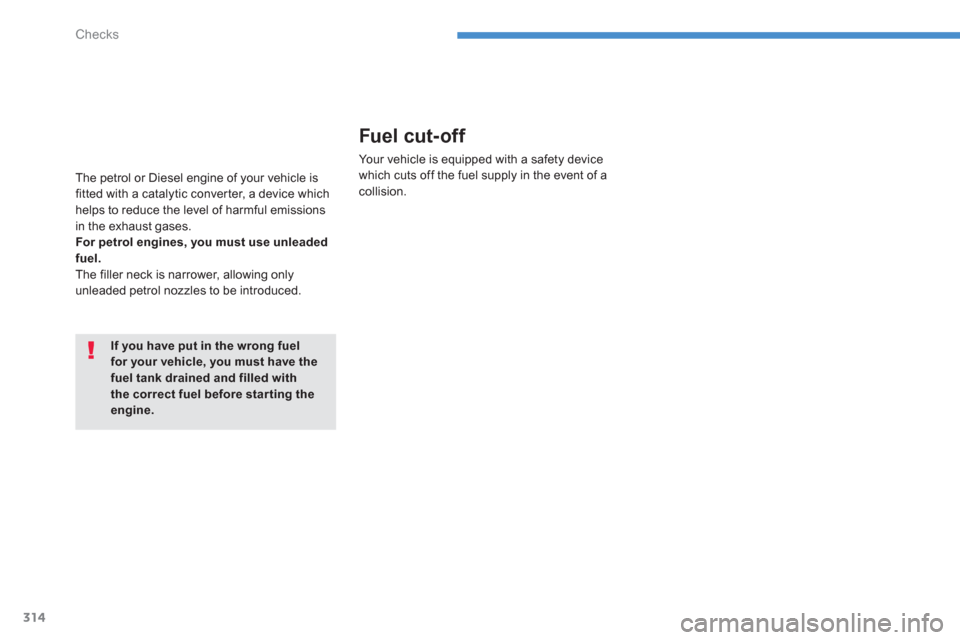
314
Checks
The petrol or Diesel engine of your vehicle is fitted with a catalytic conver ter, a device which helps to reduce the level of harmful emissions
in the exhaust gases.
For petrol en
gines, you must use unleaded fuel.The filler neck is narrower, allowing only
unleaded petrol nozzles to be introduced.
If you have put in the wrong fuel for your vehicle, you must have thefuel tank drained and filled withthe correct fuel before star ting the engine.
Fuel cut- of f
Your vehicle is equipped with a safety device
which cuts off the fuel supply in the event of acollision.
Page 317 of 420
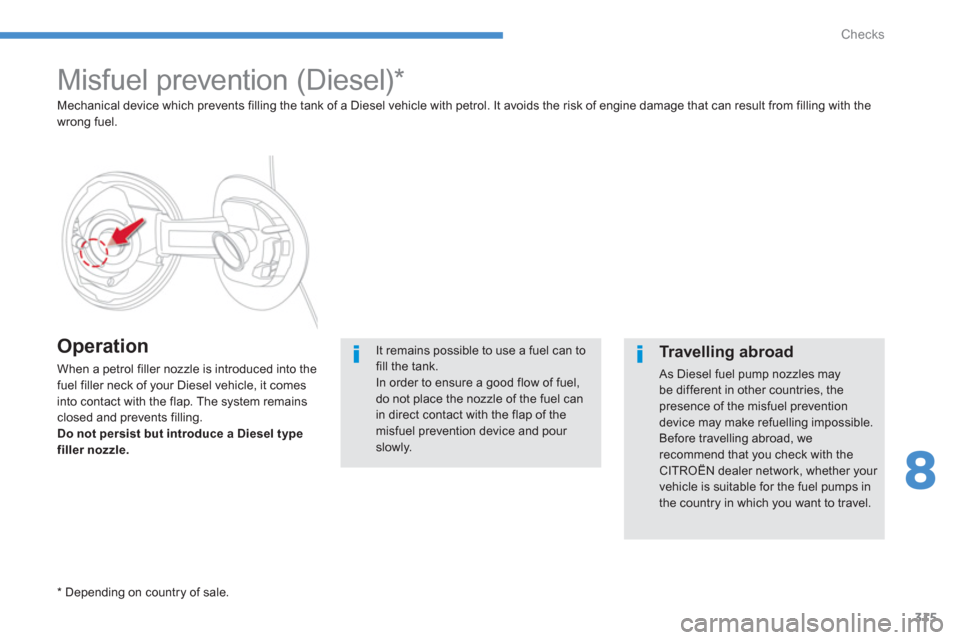
315
8
Checks
Misfuel prevention (Diesel) *
Operation
When a petrol filler nozzle is introduced into the
fuel filler neck of your Diesel vehicle, it comes
into contact with the flap. The system remainsclosed and prevents filling.Do not persist but introduce a Diesel type filler nozzle.
*
Depending on country of sale. Mechanical device which prevents fillin
g the tank of a Diesel vehicle with petrol. It avoids the risk of engine damage that can result from filling with the
wrong fuel.
It remains possible to use a fuel can tofill the tank. In order to ensure a good flow of fuel,do not place the nozzle of the fuel can in direct contact with the flap of the misfuel prevention device and pour slowly.
Travelling abroad
As Diesel fuel pump nozzles may be different in other countries, thepresence of the misfuel prevention device may make refuelling impossible.
Before travelling abroad, werecommend that you check with the CITROËN dealer network, whether your vehicle is suitable for the fuel pumps inthe country in which you want to travel.
Page 318 of 420
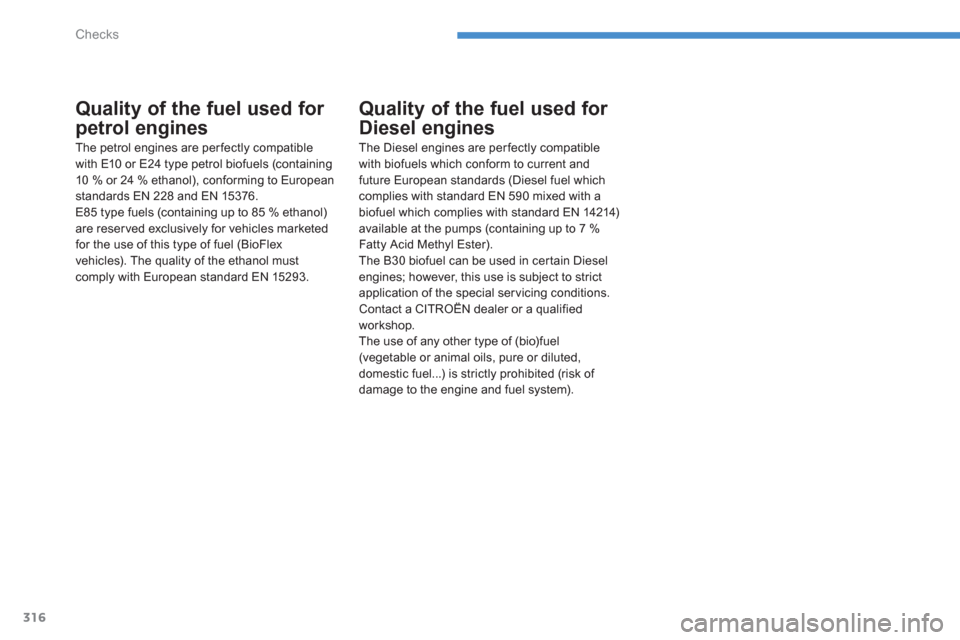
316
Checks
Quality of the fuel used for
petrol engines
The petrol engines are perfectly compatible
with E10 or E24 type petrol biofuels (containing10 % or 24 % ethanol), conforming to Europeanstandards EN 228 and EN 15376.
E85 type fuels (containing up to 85 % ethanol)
are reserved exclusively for vehicles marketed
for the use of this type of fuel (BioFlex
vehicles). The quality of the ethanol mustcomply with European standard EN 15293.
Quality of the fuel used for
Diesel engines
The Diesel engines are perfectly compatible
with biofuels which conform to current andfuture European standards (Diesel fuel whichcomplies with standard EN 590 mixed with abiofuel which complies with standard EN 14214)
available at the pumps (containing up to 7 %Fatty Acid Methyl Ester).
The B30 biofuel can be used in cer tain Diesel engines; however, this use is subject to strict
application of the special ser vicing conditions.Contact a CITROËN dealer or a qualified
workshop.
The use of any other type of (bio)fuel (vegetable or animal oils, pure or diluted,
domestic fuel...) is strictly prohibited (risk of
damage to the engine and fuel system).
Page 319 of 420
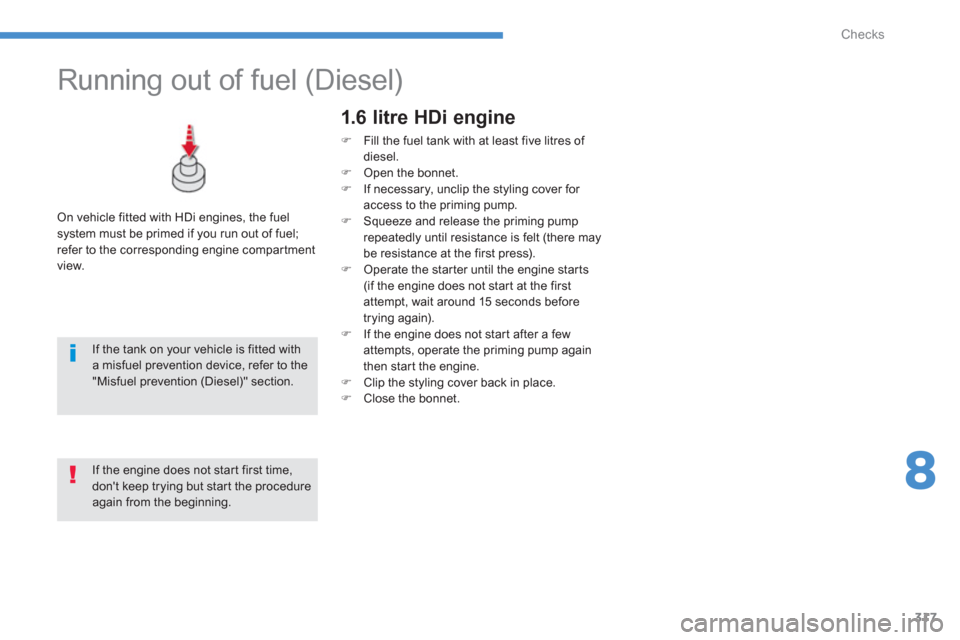
317
8
Checks
Running out of fuel (Diesel)
On vehicle fitted with HDi engines, the fuel system must be primed if you run out of fuel;
refer to the corresponding engine compar tment
view.
1.6 litre HDi engine
�)
Fill the fuel tank with at least five litres of diesel.
�)
Open the bonnet.�)
If necessary, unclip the styling cover for
access to the priming pump.�) Squeeze and release the priming pumprepeatedly until resistance is felt (there may be resistance at the first press). �)
Operate the star ter until the engine starts(if the engine does not star t at the first
attempt, wait around 15 seconds before
tr
ying again). �) If the engine does not star t after a few
attempts, operate the priming pump again
then star t the engine.�) Clip the styling cover back in place. �)
Close the bonnet.
If the tank on your vehicle is fitted witha misfuel prevention device, refer to the"Misfuel prevention (Diesel)" section.
If the engine does not star t first time, don't keep trying but star t the procedureagain from the beginning.
Page 320 of 420
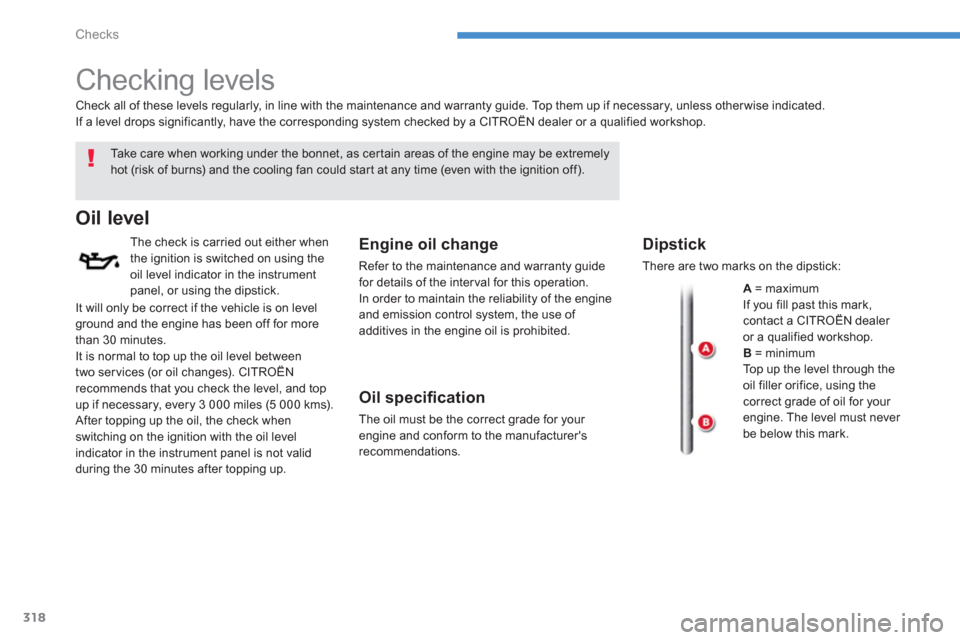
318
Checks
Checking levels
Ta k e c a r e w h e n w o r k i ng under the bonnet, as certain areas of the engine may be extremelyhot (risk of burns) and the cooling fan could star t at any time (even with the ignition off).
Oil level
The check is carried out either when
the ignition is switched on using theoil level indicator in the instrument
panel, or using the dipstick.
Engine oil change
Refer to the maintenance and warranty guidefor details of the interval for this operation.
In order to maintain the reliability of the engine
and emission control system, the use of
additives in the engine oil is prohibited.
Oil specifi cation
The oil must be the correct grade for your engine and conform to the manufacturer'srecommendations.
Check all of these levels re
gularly, in line with the maintenance and warranty guide. Top them up if necessary, unless other wise indicated.
If a level drops significantly, have the corresponding system checked by a CITROËN dealer or a qualified workshop.
Dipstick
There are two marks on the dipstick:
A= maximum
If you fill past this mark, contact a CITROËN dealer or a qualified workshop. B= minimum
Top up the level through the
oil filler orifice, using thecorrect grade of oil for your engine. The level must never be below this mark.
It will onl
y be correct if the vehicle is on level ground and the engine has been off for more
than 30 minutes.It is normal to top up the oil level between
two ser vices (or oil changes). CITROËNrecommends that you check the level, and top
up if necessary, every 3 000 miles (5 000 kms).
After topping up the oil, the check whenswitching on the ignition with the oil level
indicator in the instrument panel is not valid
durin
g the 30 minutes after topping up.
Page 321 of 420
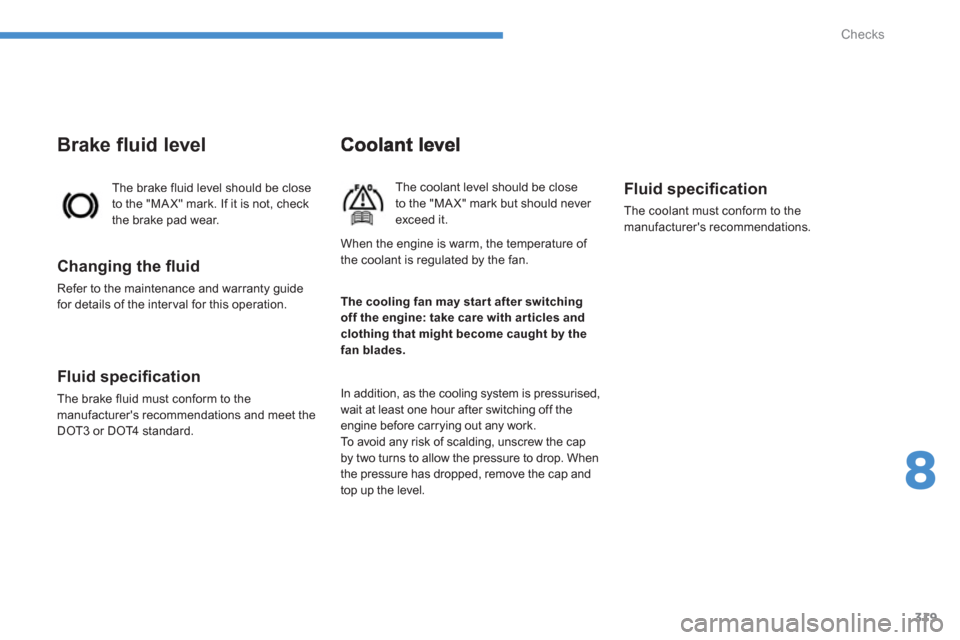
319
8
Checks
The coolant level should be closeto the "MA X" mark but should never exceed it.
In addition, as the cooling system is pressurised, wait at least one hour after switching off the
engine before carrying out any work.
To avoid any risk of scalding, unscrew the cap
by two turns to allow the pressure to drop. When
the pressure has dropped, remove the cap and
top up the level.
Fluid specifi cation
The coolant must conform to the
m
anufacturer's recommendations. Th
e brake fluid level should be close
to the "MA X" mark. If it is not, check
the brake pad wear.
Brake fluid level
Changing the fl uid
Refer to the maintenance and warranty guidefor details of the inter val for this operation.
Fluid specifi cation
The brake fluid must conform to themanufacturer's recommendations and meet the
DOT3 or DOT4 standard.
The cooling fan may star t after switching off the engine: take care with ar ticles and clothing that might become caught by the fan blades.
When the engine is warm, the temperature of
the coolant is regulated by the fan.